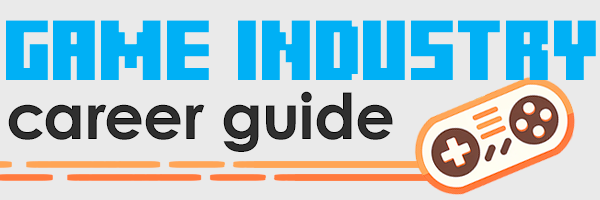Expert Guest: Patrick Connole, Technical Artist
 The role of technical artist is a fairly new career in the game industry. We’ve always had artists and programmers, but tech art evolved organically. As games got bigger and timelines got smaller, studios needed people who could program tools, rigs, and automation – but also have a deep understanding of the artistic process. Thus, the Technical Artist was born!
The role of technical artist is a fairly new career in the game industry. We’ve always had artists and programmers, but tech art evolved organically. As games got bigger and timelines got smaller, studios needed people who could program tools, rigs, and automation – but also have a deep understanding of the artistic process. Thus, the Technical Artist was born!
Many artists may not describe themselves as “technical.” Even so, the tech art career path is worth considering if you want to differentiate yourself. There’s a high volume of artists graduating from game and art schools every year, and building your technical chops could help you stand out from the crowd. Also, salary surveys show that tech artists can earn salaries up to 25% higher than production artists, so it’s worth taking a look at from a financial perspective as well.
Patrick Connole is a professional video game technical artist. But like many tech artists, he didn’t start out that way. We spoke with Pat about what a technical artist is and what they do, and why tech-savvy game artists should consider leaping into this new hybrid role that melds art, programming, customer service, welding… and the Star Trek Enterprise…?
The technical artist’s job is different in every game studio, so a lot of people are unclear about the role. Can you shed some light?
There are two categories of TA’s I’ve seen: Those on the tool-development side, and those who are production artists that do technical things like art for complicated boss fights, specialized character rigging, or shader writing. The transition from production art to tool development was pretty gradual for me, but it’s all been great. With a recent focus on tools though, it’s harder to explain to my family and friends what I do: “I helped someone else make that thing you saw in the game…” My favorite reaction is, “Oh, you design the game?!” “Yes. I design the game.” [Laughs]
But because tech art can cover so many areas of production, you’ll find that job descriptions sometimes aren’t very specific. “Oh, you’re actually looking for a Character TD. Wait, no, you need a shader programmer. Actually, what you’re describing is a Pipeline Engineer…” The clearest delimiter I’ve found when trying to determine what kind of TA a company needs is to ask them if you will create assets that end up in a game. From there, you can determine if you’ll be more of an art-tools programmer, or more of an artist that is technical.
So you started out as a production artist?
I switched over to tech art after 4 or 5 years of animating in games. Animation was really satisfying, but even in school I found myself more interested in writing scripts to automate different tasks, instead of animation itself! It took me a few years to notice this as a productive endeavor instead of a distraction to work around. What helped the transition was having supportive coworkers and managers; programmers who helped me with smaller projects, and art leads who saw the value in the tech work I was doing. The company really got behind me once I went back to school for programming, and that allowed me to officially switch over to tech art within the studio, instead of having to apply somewhere else.
Your formal schooling includes animation, computer science, and even physics and industrial technology (whatever that is!). Maybe it’s not surprising that you continued into an eclectic job like tech art.
I enjoyed most everything I tried in school, which made it very difficult to pick a major! Industrial Technology was a tour of heavy-industry production processes, and the program included some industrial design courses that have definitely influenced my approach to UI layout and flow. The design teacher had a great mantra he liked to throw around, paraphrasing: “Give a welder a problem to solve, and they’ll solve it with welding. Your job is to not be tied to any one tool.” This totally applies to my work as a tech artist, as it’s easy to become attached to the tools you’re familiar with. “How can I solve this problem with Maya and Python?” Well, maybe it’d be better to approach this particular situation with Excel and VBA. Unfortunately. [Laughs]
The computer science courses I took helped me expedite the transition from animator to tech artist, and they were invaluable in helping me design tools that are extensible and object oriented. There is a great program at UW for people who want to get into computer science and already have a degree in something else. I highly recommend it!
Have any of the video game schools started offering technical art courses?
I was surprised to find that they have! We had an intern on one project at Griptonite that was training to be a tech artist at DigiPen in Redmond. I was impressed with both his skills set and the program he was in, because it seemed to mimic a real world production environment.
If you’re lucky enough to be in school now with a program like that, I’d highly recommend it! There are other resources online as well, like Rigging Dojo and a million websites and communities to join. Besides schooling and online sources, the best thing you can do on your own is to have a personal project that requires tech solutions. If you’re an animator, write a MEL script to duplicate/constrain a bind hierarchy. Then do it in PyMEL recursively, with feeling. If you’re an environment artist, start playing with the Python Imaging Library, and see if you can mimic any common steps you do in Photoshop.
What are the top 2 or 3 talents that a technical artist needs to succeed in games?
Because the work can be so broad, you really need to enjoy the process of learning (and struggling with) new things. This is especially true at smaller studios where the roles are less specialized, and you’re exposed to, well, everything. You also need to love customer service, because much of your work will be helping people with your own tools, 3rd-party tools, and general tech support. And it’s very helpful to go deep in a specific technical skill like environment art, animation, or special effects.
That sounds like a lot to keep up with. How do you stay on top of the constant stream of new tech?
It can be really overwhelming if you let it, and can actually be a negative distraction sometimes. A problem you can face in school and at work is being too distracted with the tools, instead of the products you’re trying to make with those tools. “Do you have the latest version of ZBrush? Oh, it’s lame now, and MudBox is totally underground, dude. Oh, you’re only on CS3? Haven’t heard of DDO? Not using 0MQ yet?” It’s exhausting! You end up downloading every package and plug-in, then fall victim to the trap of “I can do anything! So I will do nothing.”
So, you need to find a balance of being up to date, but not weighed down. I’ve had the lucky position of working with people who specialize in great tools and plug-ins, or have the foresight to see the value in some newer software. Using their input has really helped me find a balance between staying informed on future technology, but focused on what needs to happen right now to get product out the door. The best resource is production artists! They are personally motivated to find faster/better workflows and solutions to use, and they love partnering with tech artists to find or create better tools.
Any online resources you’d recommend?
I check the python_inside_maya Google Group and Tech-Artists.org every day. For specific problem solving, most resources end up being on the Autodesk Area forums, CGTalk archives, or Stack Overflow, as well as the blogs of many well-known tech artists like Jason Parks and Nathan Horne.
Some say that art and programming use totally opposite sides of the brain. How do you find a balance?
I’m still not settled on the left/right brain question. I’ve seen a concept artist use a picture of the Star Trek Enterprise as a brush in Photoshop, and I’ve worked with some great pure engineers. Both types of people are creative, but one relishes in breaking rules to create great art, and the other embraces rules to design great systems. Luckily, tech art generally rides the line between the two, and I’ve been happy here!
What do you love the most about being a tech artist?
Helping people!
What other advice do you have for a tech artist just starting out, or for a game artist considering a move to tech art?
You’ll be exposed to so many different types of problems, large and small, using different languages and software packages. Enjoy it! If you’re trying to transition over to tech art while working as a production artist, the biggest piece of advice I have is: Go to school! Any formal exposure to computer science will greatly aid your approach to new languages and software, and prevent you from wasting too much time spinning your wheels. As a new tech artist, each task you perform will be a compound problem; learning a new system or language, AND creating something useful that fits the requirements of your project. Having some training in computer science will make it much easier to tackle that situation!
Patrick Connole is a Seattle native, and has worked in film and video games since 2006 as an animator and technical artist. He can be reached via LinkedIn or at his blog.
Read my new book!
Making games for a living is an incredibly rewarding career, but it’s hard to break in unless you have insider knowledge. This book levels the playing field.


Leave a Reply